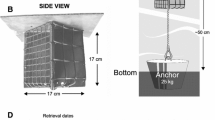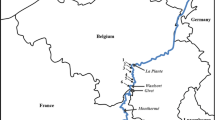Summary
Community organization was studied by experiment and observation from October 1972–October 1974 in the marine epifaunal assemblages at each end of Barnegat Inlet, New Jersey. The rock jetty at the wave-exposed eastern end of the inlet possesses an intertidal community with the following attributes: (1) a high intertidal zone dominated by the barnacle, Balanus balanoides, but also occupied by the blue mussel, Mytilus edulis, in rock crevices, (2) a mid and low intertidal zone with usually <10% free space and extreme numerical dominance by Mytilus edulis (usually >85% cover) during summer and fall, and (3) almost no intertidal predators or herbivores. The predatory seastar, Asterias forbesi, is abundant subtidally. Controlled removal experiments indicate that in the mid and low intertidal underlying barnacles perish as a consequence of the establishmentof extensive secondary cover by Mytilus, probably because Mytilus outcompetes Balanus through suffocation or starvation. Mytilus transplants demonstrate that the mussels do not survive outside of crevices in the high intertidal, which thus may represent for Balanus a refuge from competition by Mytilus.
The pilings on docks at the protected western end of Barnegat Inlet possess an intertidal epifaunal community with the following characteristics: (1) a high intertidal zone that includes Balanus balanoides, a second barnacle, Balanus eburneus, and an herbivorous gastropod, Littorina littorea, (2) a mid and low intertidal zone with usually >40% free space in the summer and fall and the remaining area covered by several abundant species with no extreme dominant, and (3) abundant predators, chiefly the oyster drill, Urosalpinx cinerea, the blue crab, Callinectes sapidus, and a mud crab, Neopanope texana sayi. Asterias forbesi, while abundant subtidally, is also occasionally present on intertidal surfaces. Controlled exclusion of predators by caging several replicate pilings at the western end of the inlet reveals that predation prevents monopolization of mid and low intertidal space by the apparent competitive dominant, Mytilus. Predation appears to be a direct cause of the relatively great temporal and spatial heterogeneity in the mid and low intertidal of these pilings.
Thus, although the Barnegat Inlet intertidal system appears to follow closely the patterns of community organization described for several other rocky intertidal coastlines, this organizational pattern is noteworthy because it is repeated here in a far more seasonal environment and with a new cast of interacting competitors and predators. That crabs play an important role as predators is novel for North America, but only perhaps because all previous North American studies have ignored the rocky intertidal zones of quiet, estuarine waters where in Europe predatory crabs are known to be extremely significant.
Similar content being viewed by others
References
Carriker, M.R.: Critical review of biology and control of oyster drills, Urosalpinx and Eupleura. U.S. Fish and Wildlife Service, Special Sci. Rep.-Fish. 148, 1–150 (1955)
Connell, J.H.: Effects of competition, predation by Thais lapillus, and other factors on natural populations of the barnacle Balanus balanoides. Ecol. Monogr. 31, 61–104 (1961a)
Connell, J.H.: The influence of interspecific competition and other factors on the distribution of the barnacle Chthamalus stellatus. Ecology 42, 710–723 (1961b)
Connell, J.H.: A predator-prey system in the marine intertidal region. I. Balanus glandula and several predatory species of Thais. Ecol. Monogr. 40, 49–78 (1970)
Connell, J.H.: Community interactions on marine rocky intertidal shores. Annu. Rev. Ecol. Syst. 3, 169–192 (1972)
Connell, J.H.: Some mechanisms producing structure in natural communities: A model and evidence from field experiments. In: Ecology and evolution of communities (M.L. Cody and J.M. Diamond, eds.), pp. 460–490. Cambridge: Belknap Press 1975
Darnell, R.M.: Food habits of fishes and larger invertebrates of Lake Pontchartrain, Louisiana, an estuarine community. Publ. Univ. Texas Inst. Mar. Sci. 5, 353–416 (1958)
Dayton, P.K.: Competition, disturbance, and community organization: The provision and subsequent utilization of space in a rocky intertidal community. Ecol. Monogr. 41, 351–389 (1971)
Ebling, F.J., Kitching, J.A., Muntz, L., Taylor, C.M.: The ecology of Lough Ine. XIII. Experimental observations of the destruction of Mytilus edulis and Nucella lapillus by crabs. J. Anim. Ecol. 33, 73–82 (1964)
Hamilton, P.V.: Predation on Littorina irrorata (Mollusca: Gastropoda) by Callinectes sapidus (Crustacea: Portunidae). Bull. Mar. Sci. 26, 403–409 (1976)
Harger, J.R.E.: Competitive coexistence. Maintenance of interacting associations of the sea mussels Mytilus edulis and Mytilus californianus. Veliger 14, 387–410 (1972)
Hoshiai, T.: Synecological study on intertidal communities. VI. A synecological study on the intertidal zonation of the Asamushi coastal area with special reference to its reformation. Bull. Marine Biol. Sta. Asamuchi Tohoku Univ. 12, (2), 93–126 (1965)
Jackson, J.B.C.: Competition on marine hard substrata: the adaptive significance of solitary and colonial strategies. Amer. Naturalist 111, 743–767 (1977)
Kitching, J.A., Ebling, F.J.: Ecological studies at Lough Ine. Advan. Ecol. Res. 4, 198–291 (1967)
Kitching, J.A., Sloane, J.F., Ebling, F.J.: The ecology of Lough Ine. VIII. Mussels and their predators. J. Anim. Ecol. 28, 331–341 (1959)
Levin, S.A., Paine, R.T.: Disturbance, patch formation, and community structure. Proc. Nat. Acad. Sci. 71, 2744–2747 (1974)
Lewis, J.R.: The ecology of rocky shores. London: English Universities Press 1964
Luckens, P.A.: Settlement and succession on rocky shores at Auckland, North Island, New Zealand. N.Z. Oceanogr. Inst. Mem. 70, 5–64 (1976)
Macmillan, D.H.: Tides. New York: Elsevier Publishing Co. 1966
Menge, B.A.: Foraging strategy of a starfish in relation to actual prey availability and environmental predictability. Ecol. Monogr. 42, 25–50 (1972)
Menge, B.A.: Organization of the New England rocky intertidal community: Role of predation, competition, and environmental heterogeneity. Ecol. Monogr. 46, 355–393 (1976)
Menge, B.A., Sutherland, J.P.: Species diversity gradients: synthesis of the roles of predation, competition and temporal heterogeneity. Amer. Naturalist 110, 351–369 (1976)
Menge, J.L., Menge, B.A.: Role of resource allocation, aggression, and spatial heterogeneity in coexistence of two competing intertidal starfish. Ecol. Monogr. 44, 189–209 (1974)
Osman, R.W.: The establishment and development of a marine epifaunal community. Ecol. Monogr. 47, 37–63 (1977)
Paine, R.T.: Food web complexity and species diversity. Amer. Naturalist 100, 65–75 (1966)
Paine, R.T.: The Pisaster-Tegula interaction: Prey patches, predator food preference, and intertidal community structure. Ecology 50, 950–961 (1969)
Paine, R.T.: A short-term experimental investigation of resource partitioning in a New Zealand rocky intertidal habitat. Ecology 52, 1096–1106 (1971)
Paine, R.T.: Intertidal community structure. Experimental studies on the relationship between a dominant competitor and its principal predator. Oecologia 15, 92–120 (1974), Paine, R.T., Vadas, R.L.: The effects of grazing by sea urchins, Strongylocentrotus spp., on benthic algal populations. Limnol. Oceanogr. 14, 710–719 (1969)
Roelofs, E.W., Bumpus, D.F.: The hydrography of Pamlico Sound. Bull. Mar. Sci. 3 (3), 189–205 (1953)
Seed, R.: The ecology of Mytilus edulis L. (Lamellibranchiata) on exposed rocky shores. 2. Growth and mortality. Oecologia 3, 317–350 (1969)
Seed, R.: Chapter 2, Ecology. In: Marine mussels: their ecology and physiology (B.L. Bayne, ed.), pp. 13–66. Cambridge: Cambridge University Press 1976
Southward, A.J.: The ecology of some rocky shores in the south of the Isle of Man. Proc. Trans. Liverpool Biol. Soc. 59, 1–50 (1953)
Sutherland, J.P.: Multiple stable points in natural communities. Amer. Naturalist 108, 859–873 (1974)
Sutherland, J.P., Karlson, R.H.: Development and stability of the fouling community at Beaufort, North Carolina. Ecol. Monogr. 47, 425–446 (1977)
Tagatz, M.E.: Biology of the blue crab, Callinectes sapidus Rathbun, in the St. Johns River, Florida. Fish. Bull. U.S. 67, 17–33 (1968)
Virnstein, R.W.: The importance of predation by crabs and fishes on benthic infauna in Chesapeake Bay. Ecology 58, 1199–1217 (1977)
Whittaker, R.H.: Vegetation of the Siskiyou Mountains, Oregon and California. Ecol. Monogr. 30, 279–338 (1960)
Wood, L.: Physiological and ecological aspects of prey selection by the marine gastropod Urosalpinx cinerea (Prosobranchia: Muricidae). Malacologia 6 (3), 267–320 (1968)
Young, D.K., Buzas, M.A., Young, M.W.: Species densities of macrobenthos associated with seagrass: a field experimental study of predation. J. mar. Res. 34, 577–592 (1976)
Author information
Authors and Affiliations
Additional information
This paper is dedicated to the memory of Robert H. MacArthur
Rights and permissions
About this article
Cite this article
Peterson, C.H. The importance of predation and competition in organizing the intertidal epifaunal communities of Barnegat Inlet, New Jersey. Oecologia 39, 1–24 (1979). https://doi.org/10.1007/BF00345993
Received:
Issue Date:
DOI: https://doi.org/10.1007/BF00345993




